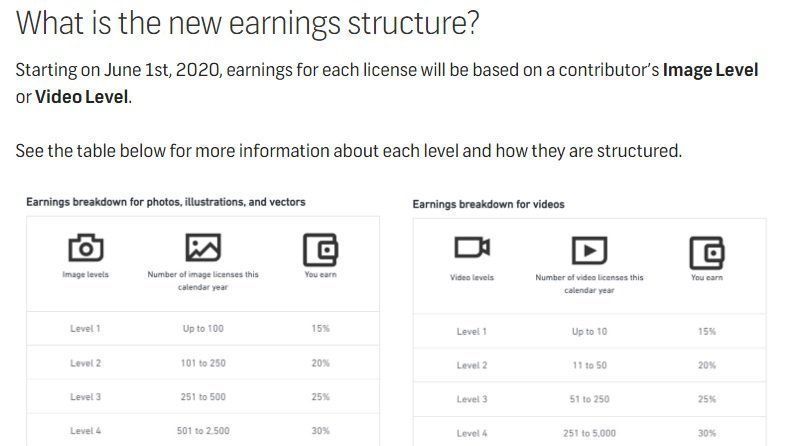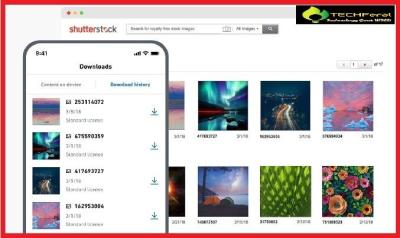Ever wondered how stock photo giants like Shutterstock operate behind the scenes? Shutterstock is one of the world’s leading platforms for high-quality stock images, videos, and music. It connects photographers and content creators with millions of users looking to enhance their projects. But how does it actually make money, and how do photographers earn from their work? In this section, we’ll take a quick look at
How Shutterstock Pays Photographers and Contributors
Now, let’s get into the juicy details—how does Shutterstock actually pay the talented photographers and creators who upload their work? The process is pretty straightforward but depends on a few key factors. First, contributors earn royalties whenever someone licenses one of their images, videos, or music tracks. The amount they earn per license depends on their contributor level, the type of content, and the licensing type (standard or enhanced).
Here’s a quick rundown of how payments work:
- Royalty Rates: Shutterstock offers a tiered royalty system—new contributors start at a basic rate and can earn higher percentages as they upload more content and generate sales.
- Payment Structure: Payments are calculated based on the number of downloads and the licensing type. Typically, contributors earn between 15% and 40% of the license fee, with higher earners receiving a larger percentage.
- Revenue Pools: Shutterstock pools revenue from licensing fees and distributes it to contributors based on their share of total downloads.
- Payout Thresholds: Contributors can request payments once they reach a minimum threshold—usually $35—via PayPal, Payoneer, or Skrill.
Additionally, Shutterstock offers different contributor levels—such as Standard, Premium, and Elite—that come with various benefits, including better royalty rates and promotional opportunities. As you upload more high-quality content and attract more licenses, your earning potential increases. Overall, Shutterstock‘s payment system is designed to reward consistency, quality, and volume, ensuring creators are fairly compensated for their work while providing users with a vast library of visually stunning assets.
Current Payment Rates for Photos on Shutterstock in 2025
So, you’re curious about how much you can actually earn from your photos on Shutterstock this year? Well, let’s dive into the details. As of 2025, Shutterstock’s payment structure has evolved to better reward contributors, especially those who consistently deliver high-quality content.
Shutterstock uses a tiered royalty system based on your lifetime earnings and the type of license purchased. In simple terms, the more you sell, the higher your percentage of royalties becomes. Here’s a quick breakdown of the current rates:
| Earnings Tier | Royalty Rate per Download |
|---|---|
| Starter (up to $1,000 lifetime earnings) | 15-20% |
| Contributor (between $1,000 and $50,000) | 30-35% |
| Elite (over $50,000) | 40-45% |
For example, if your photo is downloaded under a standard license, and you’re in the Starter tier, you might earn around $0.25 to $0.50 per download, depending on the license type and your specific royalty rate. In the Elite tier, that amount could rise significantly, potentially earning you over $1 per download.
It’s also worth noting that Shutterstock offers different payment options, such as PayPal, Skrill, or bank transfer, with minimum payout thresholds usually around $35. Payments are processed monthly, so once you reach that threshold, you can expect your earnings shortly after.
While these rates might seem modest at first glance, remember that the volume of downloads can make a big difference. Top contributors often make a substantial income because they generate hundreds or even thousands of downloads each month.
Factors Influencing Shutterstock Photo Earnings
Understanding what influences your earnings is key to maximizing your income on Shutterstock. Several factors can impact how much you make from your photos, and being aware of them can help you optimize your portfolio.
Here are some of the main factors:
- Image Quality and Relevance: High-resolution, well-composed, and relevant images tend to sell better. Clear subjects, good lighting, and professional editing can make your photos stand out.
- Keywording and Metadata: Properly tagging your images with accurate and descriptive keywords helps buyers find your photos easily. Think about what terms a customer would search for and include them thoughtfully.
- Trending Topics and Niche Markets: Photos that tap into current trends or cater to niche markets often see higher demand. For example, images related to remote work, sustainability, or specific industries might get more downloads.
- Consistency and Portfolio Size: Regularly uploading new images can boost your visibility and sales. A larger, diverse portfolio increases the chances of your photos being purchased.
- License Types: Standard licenses typically generate lower payouts but are more frequently purchased, while enhanced licenses command higher prices but are less common.
- Contributor Level and Reputation: As you earn more and build a good reputation, Shutterstock may prioritize your images in search results, leading to more sales.
Additionally, seasonal factors and global events can influence demand. For instance, holiday-themed images tend to sell well during specific times of the year, and newsworthy events might spike interest in certain topics.
In summary, your earnings on Shutterstock depend heavily on the quality of your images, how well you optimize them, and staying attuned to market trends. Focusing on these areas can help you grow your income steadily over time.
Tips to Maximize Your Earnings as a Shutterstock Contributor
So, you’re diving into the world of stock photography on Shutterstock and want to make the most of your efforts. Great! Earning more isn’t just about uploading a ton of images — it’s about quality, strategy, and understanding what buyers are really looking for. Here are some tried-and-true tips to help you boost your earnings as a Shutterstock contributor:
- Create High-Quality, Unique Content: Stock buyers love fresh, original images. Focus on creating crisp, well-lit photos that stand out. Avoid overused themes unless you add a unique twist. Think about current trends but also timeless subjects.
- Keyword Strategically: Proper keywording is key. Use relevant, specific keywords that accurately describe your images. Think about what a buyer might search for. Use both broad and niche keywords to increase your images’ visibility.
- Stay Consistent and Upload Regularly: The more quality images you upload, the higher your chances of earning. Establish a routine — whether it’s weekly or bi-weekly — to keep your portfolio fresh and engaging for buyers and the Shutterstock algorithm.
- Focus on Popular and Trending Topics: Keep an eye on current events, seasons, and trending themes. Images related to holidays, technology, health, or remote work tend to perform well. Use Shutterstock’s trending sections or tools to identify hot topics.
- Optimize Your Metadata: Don’t just add keywords — craft compelling titles and descriptions that tell a story about your image. Good metadata helps your images get discovered more easily.
- Engage with the Community: Participate in forums or social media groups for stock contributors. Sharing tips and feedback can inspire new ideas and improve your skills.
- Review Your Analytics: Shutterstock provides insights into which images sell best. Use this data to inform your future uploads. Focus on creating more of what works and refine or remove underperforming content.
Remember, earning well on Shutterstock is a marathon, not a sprint. Patience, persistence, and continual learning are your best tools. Keep honing your craft, stay updated on market trends, and don’t be afraid to experiment with different styles and subjects. Over time, your efforts will pay off, and you’ll see your earnings grow!
Comparing Shutterstock Payment Rates with Other Stock Photo Platforms
When it comes to earning from your photos, not all stock platforms are created equal. Each has its own payment structure, licensing options, and contributor benefits. Let’s take a quick tour of how Shutterstock stacks up against other popular platforms in terms of payment rates and overall earning potential:
| Platform | Royalty Rate / Earnings Model | Additional Notes |
|---|---|---|
| Shutterstock | Starting at 15% for new contributors, increasing up to 42% based on lifetime earnings and exclusivity. | Offers high-volume earning potential with a tiered royalty system. Also provides subscription and on-demand sales. |
| Standard contributors earn 15-20% per sale; exclusive contributors can earn 25-45%. | Exclusivity can boost earnings, but limits distribution to other platforms. | |
| Earn approximately 33% of the sale price. | Integrated with Adobe Creative Cloud, offering good visibility among creative professionals. | |
| Earn 25-60% per download, depending on exclusivity and contributor level. | Offers flexible licensing options and a loyal customer base. | |
| Unsplash offers free images, but Getty Images licenses content for higher rates; contributors can earn 20-30%. | Higher earnings potential but more selective submission process. |
While Shutterstock’s tiered royalty system might seem modest at first glance, it rewards consistent contributors and those who choose exclusivity. Platforms like Adobe Stock offer a higher percentage per sale, but their contributor bases and licensing models differ. For instance, Getty Images tends to cater to more premium clients, which can lead to larger licensing fees but also more selective submissions.
Ultimately, your choice might depend on your niche, your willingness to be exclusive, and how much effort you want to put into each platform. Many successful contributors diversify their portfolio across multiple sites to maximize their earnings and reach different audiences.
In summary, understanding the nuances of each platform’s payment structure helps you make informed decisions and strategize your uploads for the best financial return. Keep an eye on changing rates and policies, and adapt your approach accordingly to stay profitable in the competitive world of stock photography.
Conclusion and Final Thoughts on Shutterstock Photo Payments in 2025
As we look ahead to 2025, understanding Shutterstock’s photo royalty structure is essential for photographers aiming to maximize their earnings. The platform continues to evolve, offering multiple licensing options that impact payment rates. Contributors should familiarize themselves with the current rates, which vary based on factors such as image exclusivity, contributor level, and subscription versus on-demand sales.
Key points to consider include:
- Royalty Rates: Standard royalties typically range from 15% to 40%, depending on contributor tier and licensing type.
- Payment Methods: Shutterstock offers various payout options, including PayPal, Payoneer, and bank transfers, ensuring flexible access to earnings.
- Exclusive vs. Non-Exclusive: Exclusive contributors often enjoy higher royalty rates, but this requires a commitment to exclusive licensing rights.
- Trends to Watch: The shift towards subscription-based models influences royalty calculations, making it crucial for contributors to adapt their strategies accordingly.
Ultimately, success on Shutterstock in 2025 depends on understanding these dynamics and actively managing your portfolio to align with platform changes. Staying informed about updates and leveraging high-quality, versatile images will help maximize your royalty earnings and build a sustainable income stream.
By mastering the nuances of Shutterstock’s payment system and staying adaptable, photographers can thrive in the evolving stock photography marketplace in 2025 and beyond.



